Shoreline Dynamics of Chongming Island and Driving Factor Analysis Based on Landsat Images
Abstract
:1. Introduction
2. Materials and Methods
2.1. Study Area
2.2. Data Collection
2.3. Analytical Methods
2.3.1. Automatic Shoreline Extraction from Remote Sensing Images
2.3.2. Linear Model and Segmented Linear Regression for Extracted Long-Term Shoreline Data
3. Results
3.1. Shoreline Extraction Results Based on the Method of LISA
3.2. Overall Changes of Chongming Island and the Dyanamics of Its Eastern and Northern Shorelines
3.3. Responses of Eastern and Northern Chongming Island to Sediment Inflow from Upstream
4. Discussion
4.1. Shoreline Extraction from SWIR1 and SWIR2 Bands via the Method of LISA
4.2. Shoreline Dynamics and Factors Driving Chongming Island Area
4.3. Dynamics and Driving Factors of Northern Shoreline in Chongming Island
4.4. Dynamics and Driving Factors of Eastern Shoreline in Chongming Island
4.5. Mechanisms of Eastern and Northern Shoreline Responses to Upstream Sediments
5. Conclusions
Supplementary Materials
Author Contributions
Funding
Data Availability Statement
Acknowledgments
Conflicts of Interest
Appendix A
| Year/Month | March | April | May | June | July | August | September | October | November | December | January | February |
|---|---|---|---|---|---|---|---|---|---|---|---|---|
| Year/Season | Spring | Summer | Autumn | Winter | ||||||||
| 1984 | 1 TM | |||||||||||
| 1985 | 1 TM | 1 TM | ||||||||||
| 1986 | 1 TM | 1 TM | 2 TM | |||||||||
| 1987 | 1 TM | 1 TM | 1 TM | |||||||||
| 1988 | 1 TM | 2 TM | 1 TM | 1 TM | ||||||||
| 1989 | 1 TM | 1 TM | 1 TM | 1 TM | ||||||||
| 1990 | 1 TM | 1 TM | 1 TM | |||||||||
| 1991 | 1 TM | 1 TM | ||||||||||
| 1992 | 1 TM | |||||||||||
| 1993 | 1 TM | 1 TM | ||||||||||
| 1994 | 1 TM | |||||||||||
| 1995 | 1 TM | 1 TM | 1 TM | 1 TM | ||||||||
| 1996 | 1 TM | |||||||||||
| 1997 | 1 TM | |||||||||||
| 1998 | 1 TM | |||||||||||
| 1999 | 1 TM | 1 TM | ||||||||||
| 2000 | ||||||||||||
| 2001 | 1 TM | |||||||||||
| 2002 | 1 TM | 1 TM | 1 TM | |||||||||
| 2003 | 1 TM | |||||||||||
| 2004 | 1 TM | 1 TM | 1 TM | 1 TM | ||||||||
| 2005 | 1 TM | 1 TM | ||||||||||
| 2006 | 1 TM | |||||||||||
| 2007 | 1 TM | 1 TM | 1 TM | |||||||||
| 2008 | 1 TM | 1 TM | ||||||||||
| 2009 | 1 TM | 1 TM | ||||||||||
| 2010 | 1 TM | 1 TM | 1 TM | |||||||||
| 2011 | 1 TM | 1 TM | 1 TM | |||||||||
| 2012 | ||||||||||||
| 2013 | 1 OLI | 1 OLI | ||||||||||
| 2014 | 1 OLI | |||||||||||
| 2015 | 1 OLI | 1 OLI | ||||||||||
| 2016 | 1 OLI | |||||||||||
| 2017 | 1 OLI | 1 OLI | 1 OLI | |||||||||
| 2018 | 1 OLI | 1 OLI | ||||||||||
| 2019 | 1 OLI | 1 OLI | 1 OLI | |||||||||
| 2020 | 1 OLI | 1 OLI | 1 OLI | 1 OLI | ||||||||
References
- Mondal, I.; Bandyopadhyay, J.; Dhara, S. Detecting shoreline changing trends using principle component analysis in sagar island, west bengal, india. Spat. Inf. Res. 2016, 25, 67–73. [Google Scholar] [CrossRef]
- Ge, X.; Sun, X.; Liu, Z. Object-Oriented Coastline Classification and Extraction from Remote Sensing Imagery. In Proceedings of the Remote Sensing of the Environment: 18th National Symposium on Remote Sensing of China, Wuhan, China, 14 May 2014. [Google Scholar]
- Yang, S.L.; Li, M.; Dai, S.B.; Liu, Z.; Zhang, J.; Ding, P.X. Drastic decrease in sediment supply from the yangtze river and its challenge to coastal wetland management. Geophys. Res. Lett. 2006, 33, L06408. [Google Scholar] [CrossRef]
- Liu, Y.; Li, X.; Hou, X. Spatiotemporal changes to the river channel and shoreline of the yellow river delta during a 40-year period (1976–2017). J. Coast. Res. 2019, 36, 128–138. [Google Scholar] [CrossRef]
- Cui, B.-L.; Li, X.-Y. Coastline change of the yellow river estuary and its response to the sediment and runoff (1976–2005). Geomorphology 2011, 127, 32–40. [Google Scholar] [CrossRef]
- Nienhuis, J.H.; Ashton, A.D.; Roos, P.C.; Hulscher, S.J.M.H.; Giosan, L. Wave reworking of abandoned deltas. Geophys. Res. Lett. 2013, 40, 5899–5903. [Google Scholar] [CrossRef] [Green Version]
- Lee, Y.-K.; Ry, J.-H.; Choi, J.-K.; Soh, J.-G.; Eom, J.-A.; Won, J.-S. A study of decadal sedimentation trend changes by waterline comparisons within the ganghwa tidal flats initiated by human activities. J. Coast. Res. 2011, 27, 867–869. [Google Scholar] [CrossRef]
- Tian, B.; Zhang, L.; Wang, X.; Zhou, Y.; Zhang, W. Forecasting the effects of sea-level rise at chongming dongtan nature reserve in the yangtze delta, shanghai, china. Ecol. Eng. 2010, 36, 1383–1388. [Google Scholar] [CrossRef]
- Jiang, T.; Kundzewicz, Z.W.; Su, B. Changes in monthly precipitation and flood hazard in the yangtze river basin, china. Int. J. Climatol. 2008, 28, 1471–1481. [Google Scholar] [CrossRef]
- Xue, P.; Chen, C.; Ding, P.; Beardsley, R.C.; Lin, H.; Ge, J.; Kong, Y. Saltwater intrusion into the changjiang river: A model-guided mechanism study. J. Geophys. Res. 2009, 114, C02006. [Google Scholar] [CrossRef]
- Chu, Z.; Yang, X.; Feng, X.; Fan, D.; Li, Y.; Shen, X.; Miao, A. Temporal and spatial changes in coastline movement of the yangtze delta during 1974–2010. J. Asian Earth Sci. 2013, 66, 166–174. [Google Scholar] [CrossRef]
- Yang, S.L.; Milliman, J.D.; Li, P.; Xu, K. 50,000 dams later: Erosion of the yangtze river and its delta. Glob. Planet Change 2011, 75, 14–20. [Google Scholar] [CrossRef]
- Fan, D.; Guo, Y.; Wang, P.; Shi, J.Z. Cross-shore variations in morphodynamic processes of an open-coast mudflat in the changjiang delta, china: With an emphasis on storm impacts. Cont. Shelf Res. 2006, 26, 517–538. [Google Scholar] [CrossRef]
- Zhao, B.; Wang, Z.; Chen, J.; Chen, Z. Marine sediment records and relative sea level change during late pleistocene in the changjiang delta area and adjacent continental shelf. Quat. Int. 2008, 186, 164–172. [Google Scholar] [CrossRef]
- Luan, Z.; Jin, Q. Research on water-sediment numerical simulation of middle and lower reaches of the yangtze river and estuary. Procedia Eng. 2016, 154, 582–588. [Google Scholar] [CrossRef] [Green Version]
- Milliman, J.D.; Huang-Ting, S.; Zuo-Sheng, Y.; Meade, R.H.; Milliman, J.D.; Jin, Q. Transport and deposition of river sediment in the changjiang estuary and adjacent continental shelf. Cont. Shelf Res. 1985, 4, 37–44. [Google Scholar] [CrossRef]
- Gao, S.; Wang, Y.P.; Gao, J.-H. Sediment retention at the changjiang sub-aqueous delta over a 57 year period, in response to catchment changes. Estuar. Coast. Shelf Sci. 2011, 95, 29–38. [Google Scholar] [CrossRef]
- Yang, H.F.; Yang, S.L.; Xu, K.H.; Milliman, J.D.; Wang, H.; Yang, Z.; Chen, Z.; Zhang, C.Y. Human impacts on sediment in the yangtze river: A review and new perspectives. Glob. Planet. Change 2018, 162, 8–17. [Google Scholar] [CrossRef]
- Li, M.; Chen, Z.; Yin, D.; Chen, J.; Wang, Z.; Sun, Q. Morphodynamic characteristics of the dextral diversion of the yangtze river mouth, china: Tidal and the coriolis force controls. Earth Surf. Processes Landf. 2011, 36, 641–650. [Google Scholar] [CrossRef]
- Wang, J.-H.; Zhang, D.-B.; Zhang, W.-S.; Zhang, J.-S. Impacts of different dynamic factors on the saltwater intrusion in the northern branch of the yangtze estuary. China Ocean Eng. 2019, 33, 673–684. [Google Scholar] [CrossRef]
- Xu, H.-J.; Huang, Z.; Bai, Y.-C.; Su, L.-S.; Hong, Y.-C.; Lu, T.-T.; Wang, X. Numerical analysis of sediment deposition in yangtze river estuary: Insight from conceptual estuary models. Appl. Ocean Res. 2020, 104, 102372. [Google Scholar] [CrossRef]
- Ghosh, M.K.; Kumar, L.; Roy, C. Monitoring the coastline change of hatiya island in bangladesh using remote sensing techniques. ISPRS J. Photogramm. Remote Sens. 2015, 101, 137–144. [Google Scholar] [CrossRef]
- El-Asmar, H.M.; Hereher, M.E. Change detection of the coastal zone east of the nile delta using remote sensing. Environ. Earth Sci. 2010, 62, 769–777. [Google Scholar] [CrossRef]
- Guo, Q.; Pu, R.; Bing, Z.; Gao, L. A Comparative Study of Coastline Changes at Tampa Bay and Xiangshan Harbor during the Last 30 Years. In Proceedings of the 2016 IEEE International Geoscience and Remote Sensing Symposium (IGARSS), Beijing, China, 3 November 2016. [Google Scholar]
- Xu, H. Modification of normalised difference water index (ndwi) to enhance open water features in remotely sensed imagery. Int. J. Remote Sens. 2007, 27, 3025–3033. [Google Scholar] [CrossRef]
- Liu, Z.; Yao, Z.; Wang, R. Assessing methods of identifying open water bodies using landsat 8 oli imagery. Environ. Earth Sci. 2016, 75, 873. [Google Scholar] [CrossRef]
- Feyisa, G.L.; Meilby, H.; Fensholt, R.; Proud, S.R. Automated water extraction index: A new technique for surface water mapping using landsat imagery. Remote Sens. Environ. 2014, 140, 23–35. [Google Scholar] [CrossRef]
- Xu, D.; Pu, Y.; Zhu, M.; Luan, Z.; Shi, K. Automatic detection of algal blooms using sentinel-2 msi and landsat oli images. IEEE J. Sel. Top. Appl. Earth Obs. Remote Sens. 2021, 14, 8497–8511. [Google Scholar] [CrossRef]
- Xu, D.; Zhang, D.; Shi, D.; Luan, Z. Automatic extraction of open water using imagery of landsat series. Water 2020, 12, 1928. [Google Scholar] [CrossRef]
- Kowe, P.; Mutanga, O.; Odindi, J.; Dube, T. Exploring the spatial patterns of vegetation fragmentation using local spatial autocorrelation indices. J. Appl. Remote Sens. 2019, 13, 024523. [Google Scholar] [CrossRef]
- Wang, L.; Shi, C.; Diao, C.; Ji, W.; Yin, D. A survey of methods incorporating spatial information in image classification and spectral unmixing. Int. J. Remote Sens. 2016, 37, 3870–3910. [Google Scholar] [CrossRef]
- Zhang, X. Application of satellite remote sensing to coastal topography generation: Case study of chongming island in shanghai, china. J. Appl. Remote Sens. 2009, 3, 033572. [Google Scholar] [CrossRef]
- Zhang, X.; Xiao, X.; Wang, X.; Xu, X.; Chen, B.; Wang, J.; Ma, J.; Zhao, B.; Li, B. Quantifying expansion and removal of spartina alterniflora on chongming island, china, using time series landsat images during 1995–2018. Remote Sens. Environ. 2020, 247, 111916. [Google Scholar] [CrossRef] [PubMed]
- Wu, S.; Chen, R.; Meadows, M.E. Evolution of an estuarine island in the anthropocene: Complex dynamics of chongming island, shanghai, p.R. China. Sustainability 2019, 11, 6921. [Google Scholar] [CrossRef] [Green Version]
- Xu, D.; Geng, Q.; Jin, C.; Xu, Z.; Xu, X. Tree line identification and dynamics under climate change in wuyishan national park based on landsat images. Remote Sens. 2020, 12, 2890. [Google Scholar] [CrossRef]
- Ryu, J.-H.; Won, J.-S.; Min, K.D. Waterline extraction from landsat tm data in a tidal flat—A case study in gomso bay, korea. Remote Sens. Environ. 2002, 83, 442–456. [Google Scholar] [CrossRef]
- Colditz, R.R.; Troche Souza, C.; Vazquez, B.; Wickel, A.J.; Ressl, R. Analysis of optimal thresholds for identification of open water using modis-derived spectral indices for two coastal wetland systems in mexico. Int. J. Appl. Earth Obs. Geoinf. 2018, 70, 13–24. [Google Scholar] [CrossRef]
- Frazier, P.; Page, K. Water body detection and delineation with landsat tm data. Photogramm. Eng. Remote Sens. 2000, 66, 1461–1467. [Google Scholar]
- Yang, H.F.; Yang, S.L.; Xu, K.H. River-sea transitions of sediment dynamics: A case study of the tide-impacted yangtze river estuary. Estuar. Coast. Shelf Sci. 2017, 196, 207–216. [Google Scholar] [CrossRef]
- Sun, N.; Zhu, W.; Cheng, Q. Gf-1 and landsat observed a 40-year wetland spatiotemporal variation and its coupled environmental factors in yangtze river estuary. Estuar. Coast. Shelf Sci. 2018, 207, 30–39. [Google Scholar] [CrossRef]
- Dolgopolova, E.N.; Isupova, M.V. Classification of estuaries by hydrodynamic processes. Water Resour. 2010, 37, 268–284. [Google Scholar] [CrossRef]
- Kuang, C.; Liu, X.; Gu, J.; Guo, Y.; Huang, S.; Liu, S.; Yu, W.; Huang, J.; Sun, B. Numerical prediction of medium-term tidal flat evolution in the yangtze estuary: Impacts of the three gorges project. Cont. Shelf Res. 2013, 52, 12–26. [Google Scholar] [CrossRef]
- Luo, W.; Shen, F.; He, Q.; Cao, F.; Zhao, H.; Li, M. Changes in suspended sediments in the yangtze river estuary from 1984 to 2020: Responses to basin and estuarine engineering constructions. Sci. Total Environ. 2022, 805, 150381. [Google Scholar] [CrossRef] [PubMed]
- Cai, L.; Chen, S.; Yan, X.; Bai, Y.; Bu, J. Study on high-resolution suspended sediment distribution under the influence of coastal zone engineering in the yangtze river mouth, China. Remote Sens. 2022, 14, 486. [Google Scholar] [CrossRef]
- Chen, Y.; Dong, J.; Xiao, X.; Zhang, M.; Tian, B.; Zhou, Y.; Li, B.; Ma, Z. Land claim and loss of tidal flats in the yangtze estuary. Sci. Rep. 2016, 6, 24018. [Google Scholar] [CrossRef] [PubMed]
- França, M.C.; Francisquini, M.I.; Cohen, M.C.L.; Pessenda, L.C.R.; Rossetti, D.F.; Guimarães, J.T.F.; Smith, C.B. The last mangroves of marajó island—Eastern amazon: Impact of climate and/or relative sea-level changes. Rev. Palaeobot. Palynol. 2012, 187, 50–65. [Google Scholar] [CrossRef]
- Seybold, H.; Andrade, J.S.; Herrmann, H.J. Modeling river delta formation. Proc. Natl. Acad. Sci. USA 2007, 104, 16804–16809. [Google Scholar] [CrossRef] [Green Version]
- Yang, H.F.; Yang, S.L.; Xu, K.H.; Wu, H.; Shi, B.W.; Zhu, Q.; Zhang, W.X.; Yang, Z. Erosion potential of the yangtze delta under sediment starvation and climate change. Sci. Rep. 2017, 7, 10535. [Google Scholar] [CrossRef] [Green Version]
- Pan, L.; Ding, P.; Ge, J. Impacts of deep waterway project on morphological changes within the north passage of the changjiang estuary, china. J. Coast. Res. 2012, 284, 1165–1176. [Google Scholar] [CrossRef]
- Zhu, C.; Guo, L.; Maren, D.S.; Tian, B.; Wang, X.; He, Q.; Wang, Z.B. Decadal morphological evolution of the mouth zone of the yangtze estuary in response to human interventions. Earth Surf. Processes Landf. 2019, 44, 2319–2332. [Google Scholar] [CrossRef]
- Edmonds, D.A.; Slingerland, R.L. Mechanics of river mouth bar formation: Implications for the morphodynamics of delta distributary networks. J. Geophys. Res. 2007, 112, F02034. [Google Scholar] [CrossRef] [Green Version]
- Lu, J.; Zhang, Y. Spatial distribution of an invasive plant spartina alterniflora and its potential as biofuels in china. Ecol. Eng. 2013, 52, 175–181. [Google Scholar] [CrossRef]
- Luo, X.X.; Yang, S.L.; Wang, R.S.; Zhang, C.Y.; Li, P. New evidence of yangtze delta recession after closing of the three gorges dam. Sci. Rep. 2017, 7, 41735. [Google Scholar] [CrossRef] [PubMed] [Green Version]
- Li, X.; Zhou, Y.; Zhang, L.; Kuang, R. Shoreline change of chongming dongtan and response to river sediment load: A remote sensing assessment. J. Hydrol. 2014, 511, 432–442. [Google Scholar] [CrossRef]
- Li, X.; Zhang, X.; Qiu, C.; Duan, Y.; Liu, S.; Chen, D.; Zhang, L.; Zhu, C. Rapid loss of tidal flats in the yangtze river delta since 1974. Int. J. Environ. Res. Public Health 2020, 17, 1636. [Google Scholar] [CrossRef] [PubMed] [Green Version]
- Du, J.-L.; Yang, S.-L.; Feng, H. Recent human impacts on the morphological evolution of the yangtze river delta foreland: A review and new perspectives. Estuar. Coast. Shelf Sci. 2016, 181, 160–169. [Google Scholar] [CrossRef]
- Xie, L.; Zhang, Z.; Zhang, Y.; Wang, Y.; Huang, X. Sedimentation and morphological changes at yuantuojiao point, estuary of the north branch, changjiang river. Acta Oceanol. Sin. 2013, 32, 24–34. [Google Scholar] [CrossRef]
- Zhu, B.; Yue, Y.; Borthwick, A.G.L.; Yu, W.; Liang, E.; Tang, J.; Chai, Y.; Li, Y. Decadal link between longitudinal morphological changes in branching channels of yangtze estuary and movement of the offshore depo-center. Earth Surf. Processes Landf. 2020, 45, 2689–2705. [Google Scholar] [CrossRef]
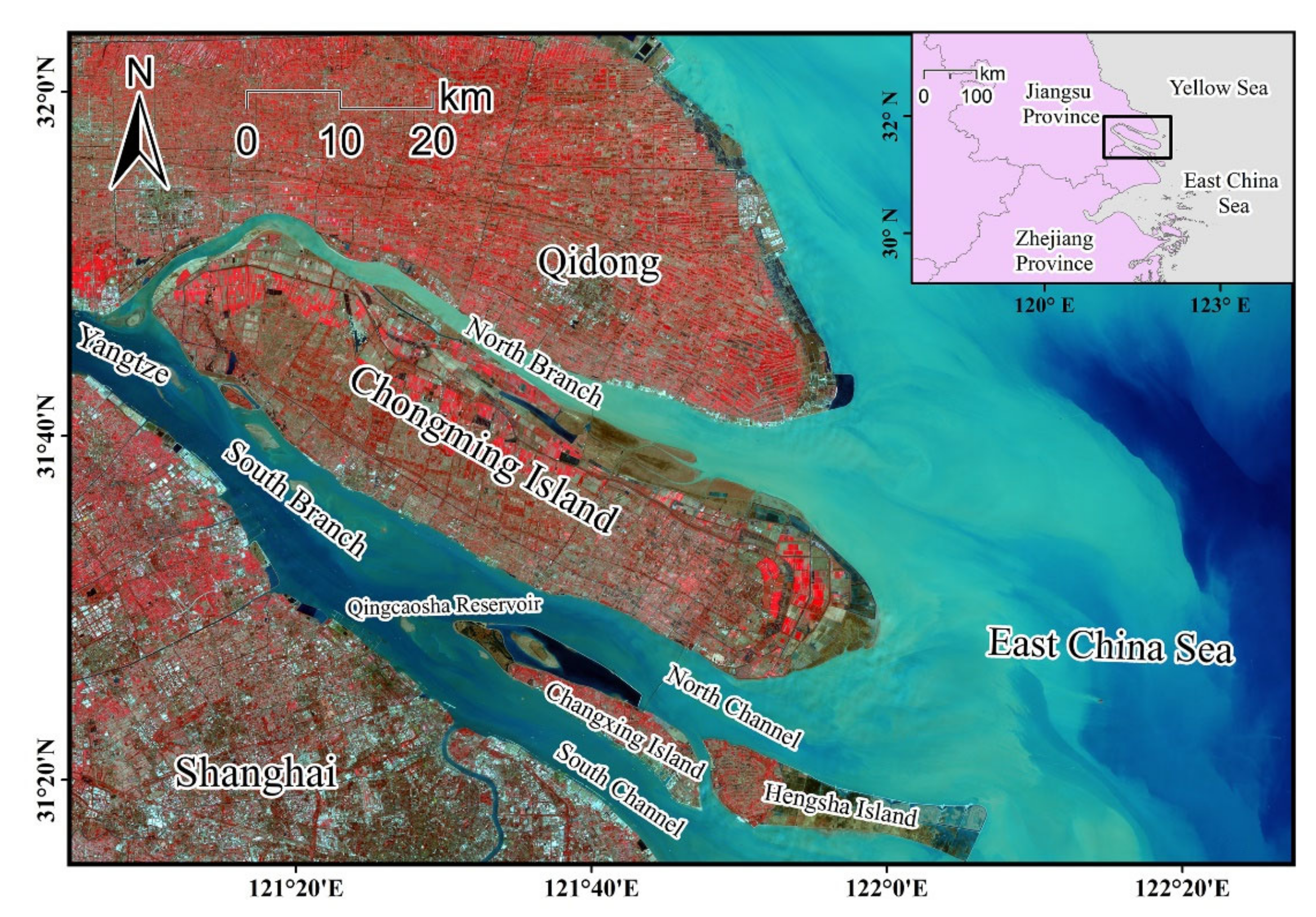

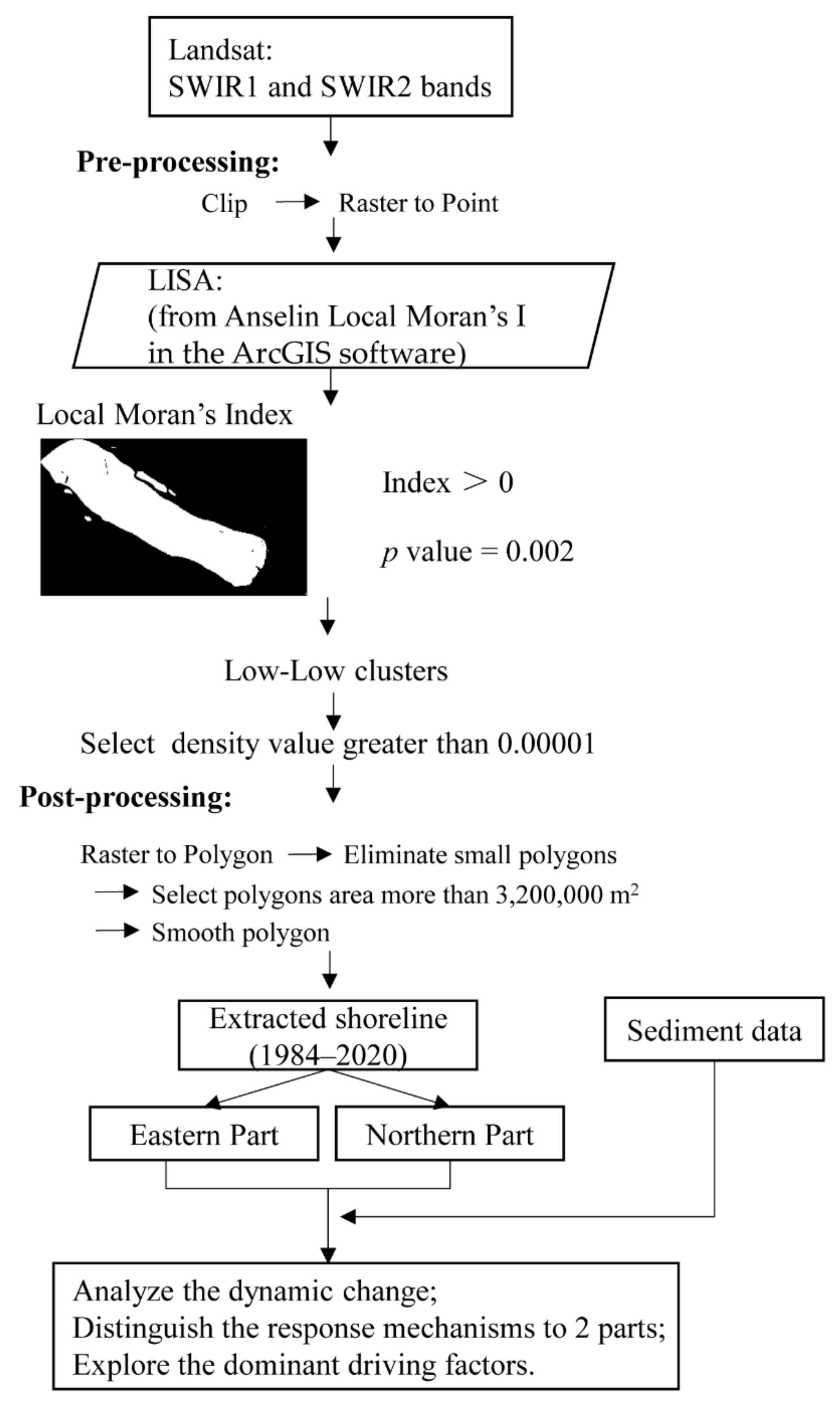

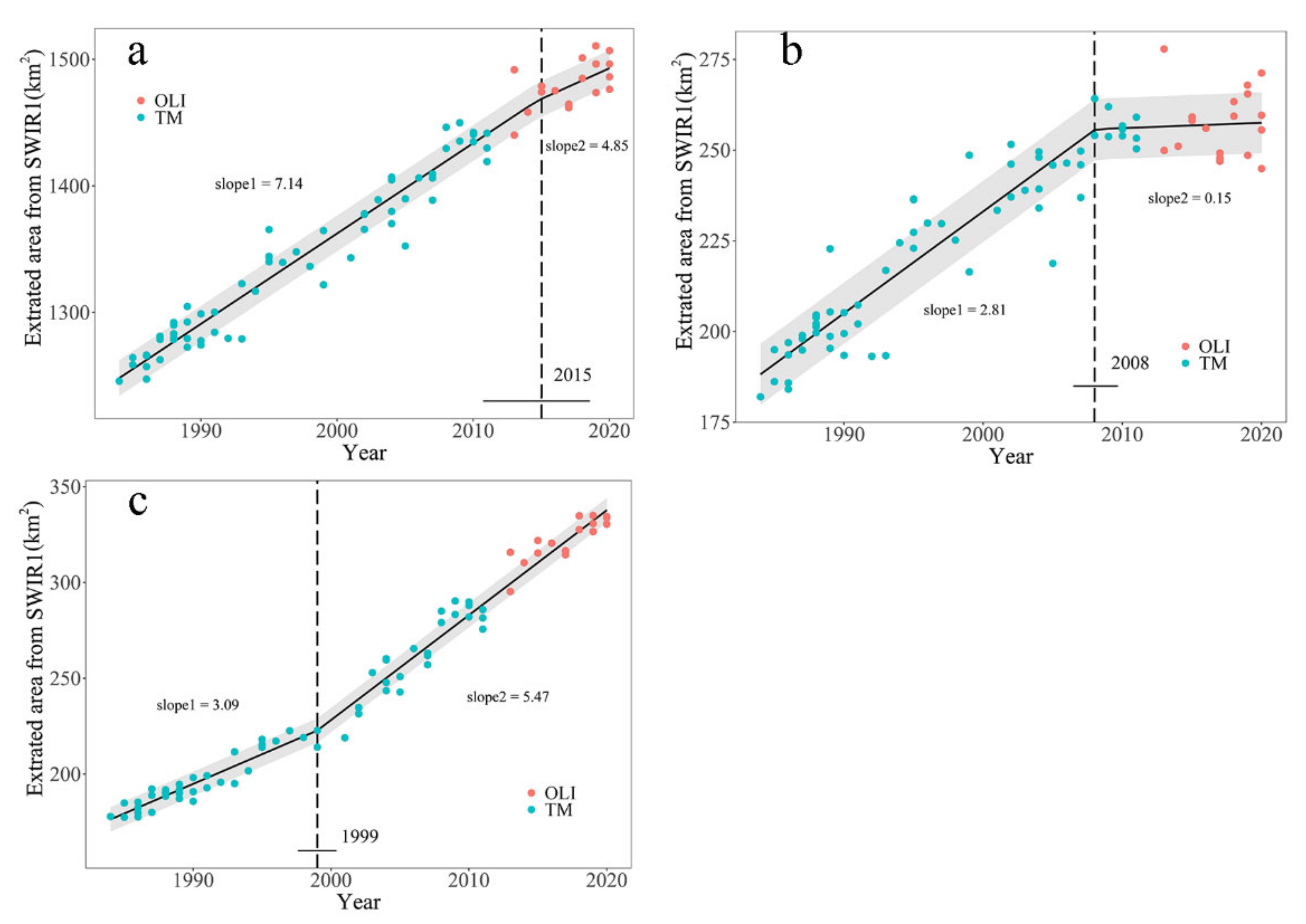
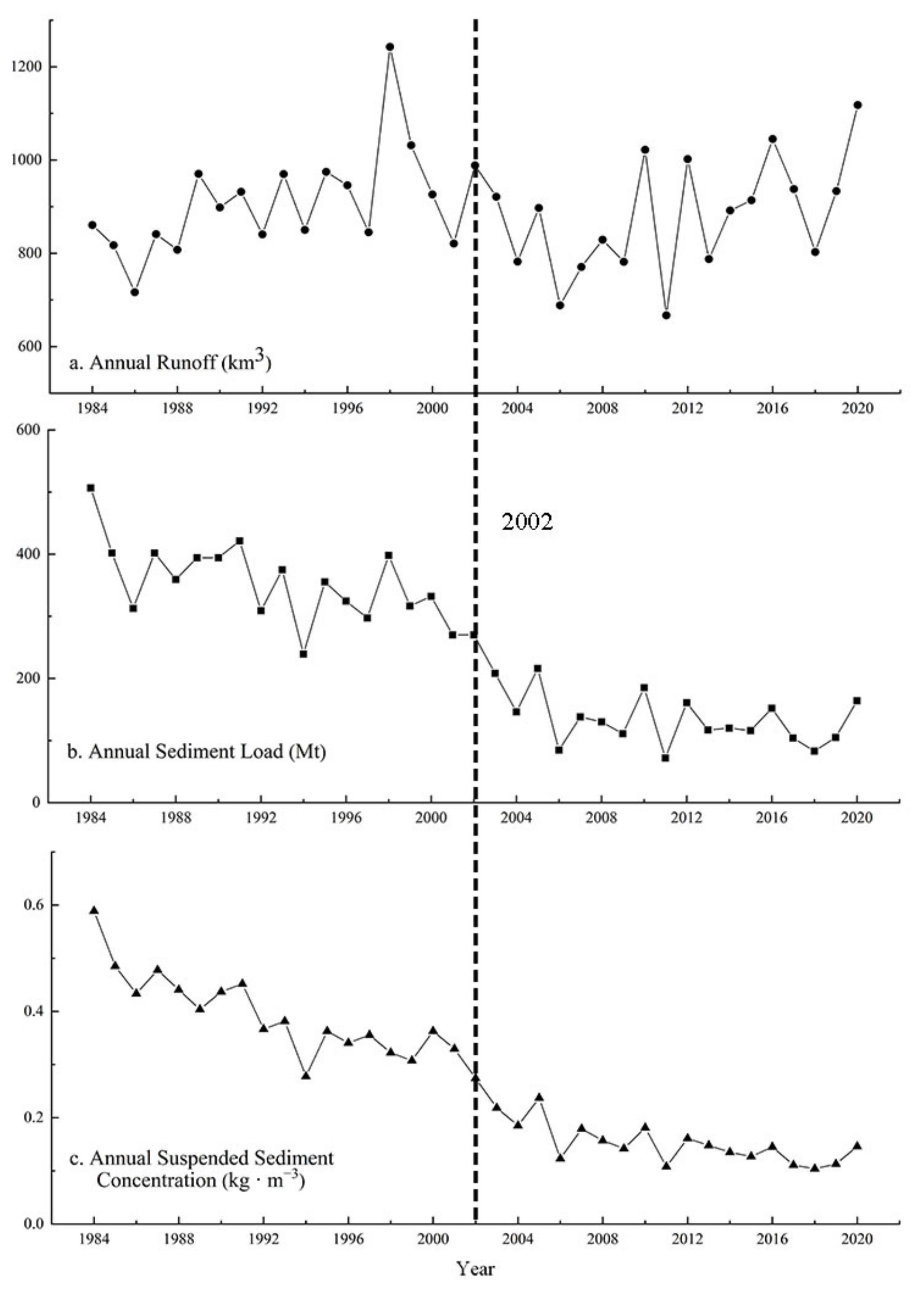

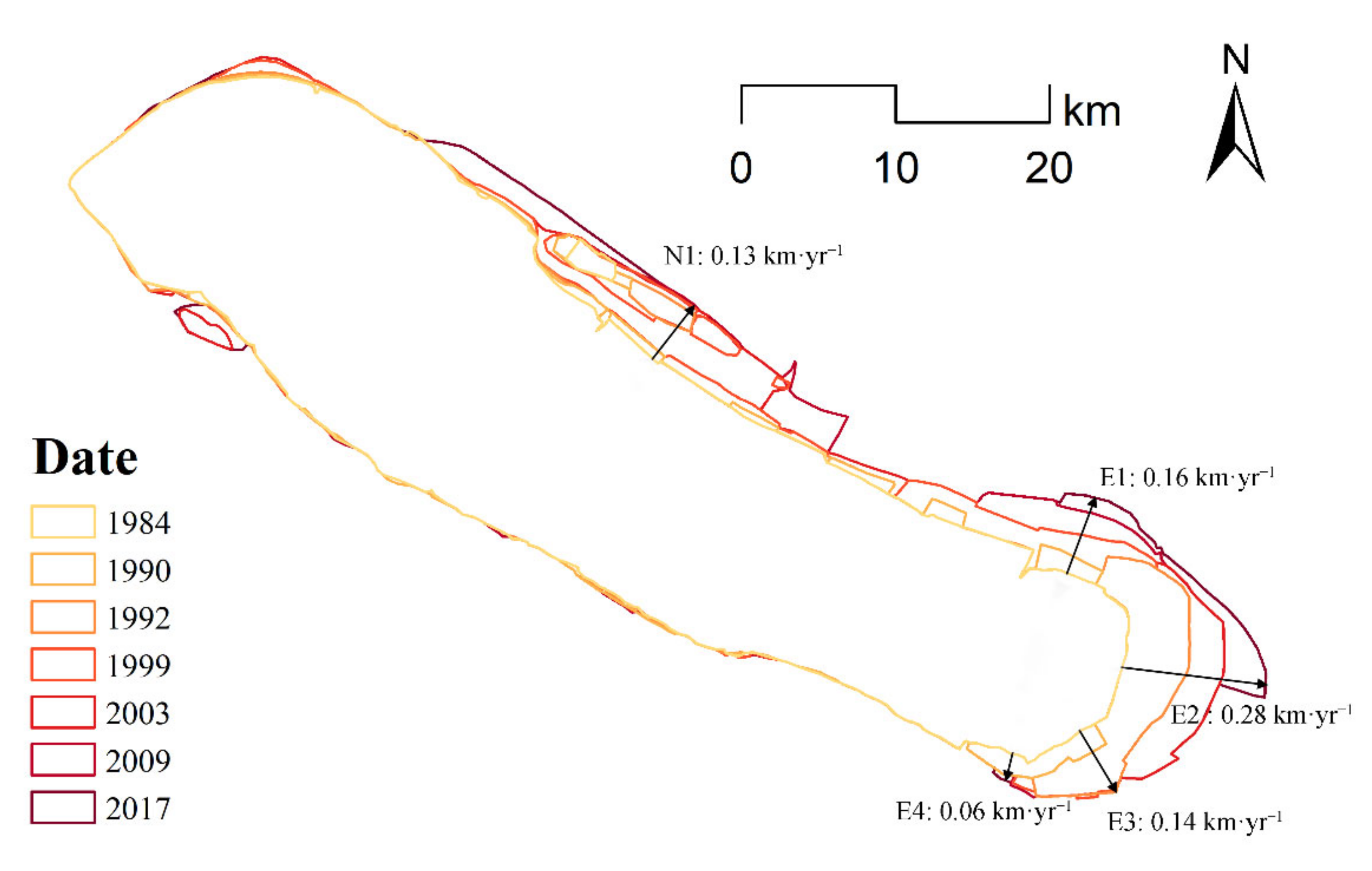
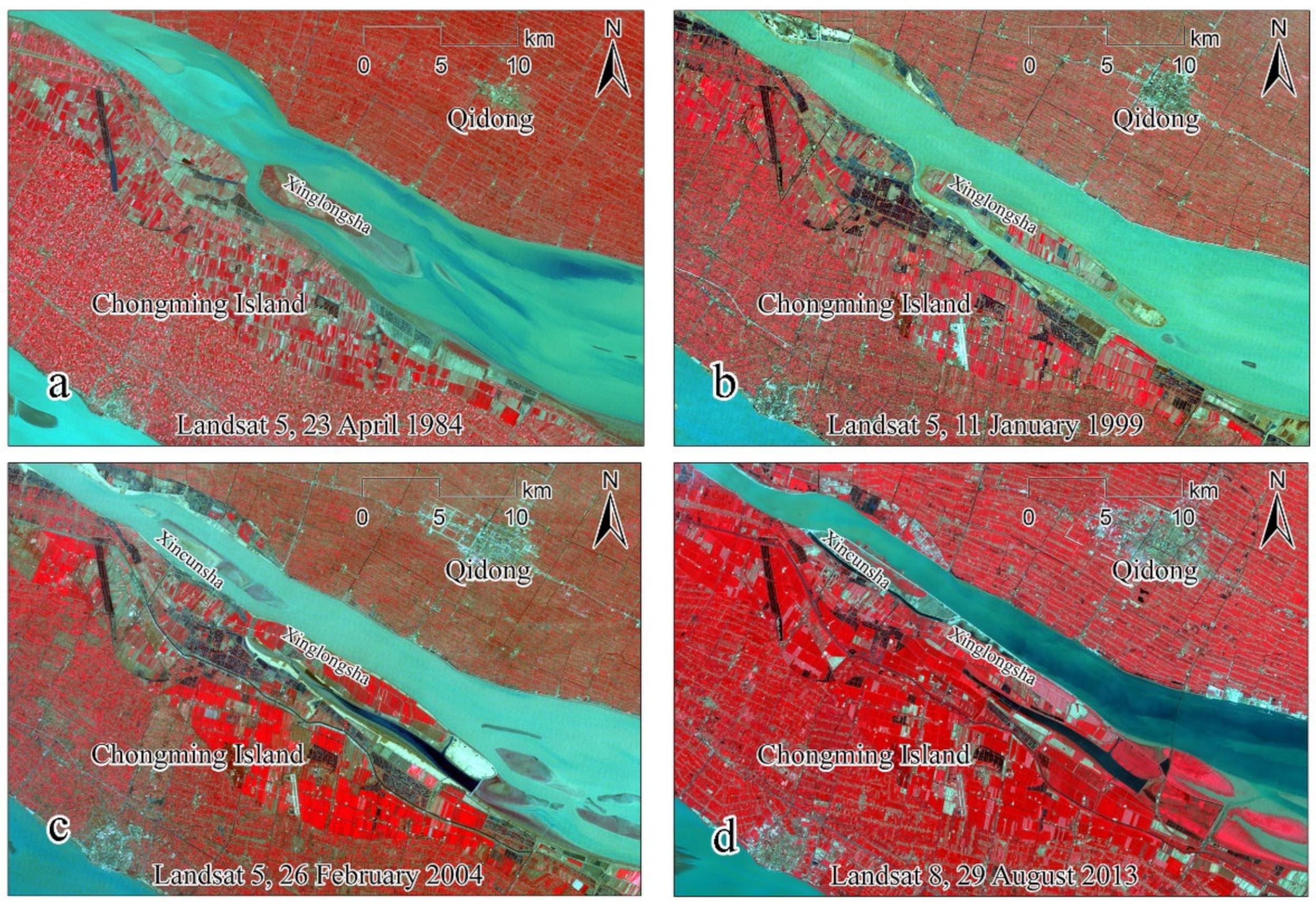
Publisher’s Note: MDPI stays neutral with regard to jurisdictional claims in published maps and institutional affiliations. |
© 2022 by the authors. Licensee MDPI, Basel, Switzerland. This article is an open access article distributed under the terms and conditions of the Creative Commons Attribution (CC BY) license (https://creativecommons.org/licenses/by/4.0/).
Share and Cite
Wang, H.; Xu, D.; Zhang, D.; Pu, Y.; Luan, Z. Shoreline Dynamics of Chongming Island and Driving Factor Analysis Based on Landsat Images. Remote Sens. 2022, 14, 3305. https://doi.org/10.3390/rs14143305
Wang H, Xu D, Zhang D, Pu Y, Luan Z. Shoreline Dynamics of Chongming Island and Driving Factor Analysis Based on Landsat Images. Remote Sensing. 2022; 14(14):3305. https://doi.org/10.3390/rs14143305
Chicago/Turabian StyleWang, Haobin, Dandan Xu, Dong Zhang, Yihan Pu, and Zhaoqing Luan. 2022. "Shoreline Dynamics of Chongming Island and Driving Factor Analysis Based on Landsat Images" Remote Sensing 14, no. 14: 3305. https://doi.org/10.3390/rs14143305
APA StyleWang, H., Xu, D., Zhang, D., Pu, Y., & Luan, Z. (2022). Shoreline Dynamics of Chongming Island and Driving Factor Analysis Based on Landsat Images. Remote Sensing, 14(14), 3305. https://doi.org/10.3390/rs14143305








